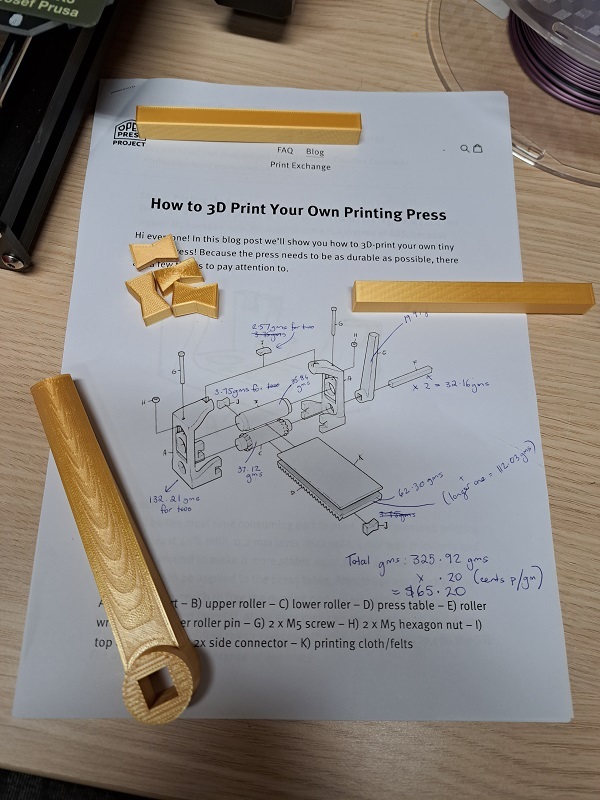3D printer producing the goods
Ashley Smyth
06 March 2023, 5:00 PM
 Waitaki Creative Wellbeing facilitators artist Natalie Carpenter (left) and peer support worker Toni Huls with the 3D printed print press. PHOTOS: Ashley Smyth
Waitaki Creative Wellbeing facilitators artist Natalie Carpenter (left) and peer support worker Toni Huls with the 3D printed print press. PHOTOS: Ashley Smyth When considering what to print on a 3D printer, another printer might not be the first thing to spring to mind - unless you’re a printmaker.
Kakanui artist Natalie Carpenter has a passion for printmaking, and has been one of two facilitators running Waitaki Creative Wellbeing, which holds free creative sessions for adults with mental distress, in Ōamaru, Palmerston and Kurow.
She had seen printing presses made using 3D printers online, and was curious.
“I had seen it - I’m a printmaker and I follow a lot of things [online], but I was down at Artsenta (in Dunedin) and they had one, and they were talking about discovering the plans again.
“I looked into it, but kind of thought, ‘oh there’s nowhere in Ōamaru that can do that’, and initially, some years ago, I priced it up and it was unaffordable.”
Meanwhile, about 18 months ago, the Ōamaru Public Library was donated its first 3D printer by a member of the public.
Reference and digital services librarian Debbie Price-Ewen said she thought the kind donor had set it up deliberately, so it was not working.
“So he sort of said, ‘here’s your instructions, heaps on YouTube, go and sort it out’.”
It took her and others about a month to get it going.
“We were really excited about it - we just started tinkering really, trying to work out what was wrong, and eventually we got there . . . and that’s when I was really into 3D printing.”
The same man then donated a second printer, which was shipped directly from the Czech Republic as a kitset.
This meant as they built, they discovered the “inner workings” of the printer, Debbie said.
A forced period of isolation for fellow librarian Martin Bratina provided the perfect opportunity to complete the build, and he brought the finished product back to work with him.
“So we had a really good machine on our hands then, so then we really started to learn heaps about how to build stuff."
But the learning hasn’t ended there - with users of the printer bringing their own knowledge and experience with them, and sharing it willingly.
A man who needed some complicated parts for his wheelchair, and had success printing them off in the past, needed one that was “sort of angular and had a slight twist to it” that didn’t print properly, Debbie said.
“He took one look at [the printer], and said this is what you need to do. So he spent probably a day with myself and Martin, and he had electronic calipers and he was looking at the calibration of the bed of the 3D printer, and that just took us to the next level.”
“Now we know exactly what we have to do, to have this not happen again.”

Plans and parts for a second print press, mid-construction, following the success of the first one.
There was also a paraglider who was visiting Oamaru for a few weeks, and he wanted to 3D print a mount for his GoPro camera, so it sat above his parachute.
“So he came in and was like, ‘I’ve done a little bit of 3D printing - not a lot - do you mind if I just sit here and have a little play?’, and I was like, ‘yeah sure, whatever you learn, teach us’.”
Debbie described his approach as “fearless”.
“He didn’t know much about it, but he went in and was like, ‘do this and do that and oh, that doesn’t work’, so it was like that really fast-failure philosophy . . . and that kind of took me, in particular, to that next level. So that was so important too.
“It’s been a year-long journey . . . going from knowing nothing, to now being able to go, ‘ooh, I think I know what that is, why that’s not working’.”
When Natalie saw Debbie was running a workshop to share her knowledge of 3D printing, she decided to go along and see how much the print press she had in mind would cost, and at least gain a good understanding of how it worked.
The cost to make was $63, but the library decided to donate the press to the Creative Wellbeing class.
Print presses were traditionally large and expensive, so the implications of this smaller, cheaper one, made it perfect for what Natalie wanted it for.
“It could be affordable for people, and I love that it’s portable because we do need to take a lot of equipment to our classes . . . we’re constantly unloading things out of our car - we don’t just take a small amount of stuff. So, the more portable the better.”
The 3D printer works by using a plan on a computer programme which “prints” with a biodegradable plastic filament - like a yarn. It lays the filament on a “bed”, one layer at a time at a temperature between 210°-220° Celsius, so it melts together.
Natalie was hoping people might see this as potentially something they could “have in their lives”, if they're interested in printmaking.
“I feel like there’s so many levels that just this one thing could bring to the community.”
The printers are part of a makerspace being created in a small room at the library, which included a Cricut cutting machine, and a sewing machine.
Debbie hoped to add to the space, and wanted it to be a place where people could have access to machinery they would not be able to afford personally.


